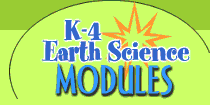USER NOTES
 Exploring the Environment® is geared toward students in grades 5-8 and 9-12. To reach more students, the program is expanding its audience to include a group typically underserved by environmental education programs: K-4 students. Exploring the Environment® is geared toward students in grades 5-8 and 9-12. To reach more students, the program is expanding its audience to include a group typically underserved by environmental education programs: K-4 students.
The K-4 Earth Science curriculum is divided into four modules based on topic: Biomes; Weather, Seasons, and Climate; Remote Sensing; and Earth System. Each module contains an overview section, online and hands-on activities, and an Earth action story.
The overview section of each module contains a wealth of information on the topic. The overviews are written on a grade 3 to 4 reading level. This makes the materials more user-friendly for teachers by digesting a lot of information and presenting it on a level their students can understand. Another benefit of the overviews being written on a low reading level is that teachers can print the pages and distribute them to students who read, adding another curricular dimension to content.
The online and hands-on activities support the topics in each module. They enable students to actively engage in the concepts they are learning and make connections between the content of the lessons and their own lives. The lesson plans for the activities include Grade Level, Essential Question, Objective, Materials, Approach, and Reflection. The activities can be used as culminating events to a lesson. They can also be used as jumping off points for taking the learning to the next level by adding more inquiry.
Inquiry is also introduced in the four Earth action stories. The stories provoke thought and promote cultural diversity. Students learn about cultural differences as they are introduced to various environmental issues. For example, through a story about Native American views on nature, students see the concept of Earth as a system. At the end of each Earth action story is a list of related problem-based learning challenges. Such challenges capitalize on the natural inquisitiveness of our youngest group of students.
Our goal is to inspire students to seek more information by asking more questions. Therefore we have included an over-arching problem-based learning challenge. The challenge ties together the concepts that students learn in each of the four modules. Your students should address this and other problem-based learning challenges using the problem-based learning model to organize their research and the presentation of their findings.
As the students work, they may need a little prodding depending on their experience and prior knowledge on the subject of gardens. You should not be directive as you implement this investigation. However, you may find it necessary to guide the students' learning if they stray away from the desired curriculum. For your convenience there are essential questions and other implementation tips at the end of these user notes. The questions address the topic areas covered in the four Earth science modules. The should help you to guide your students through the over-arching challenge.
You can use this curriculum in many ways. Each piece—the overviews, activities, Earth action stories, and the over-arching problem-based learning challenge—was created to stand alone. You can also combine two or more of the complimentary resources in countless ways. Tailor the curriculum to suit your needs. Whether you need a basic reference source with information on weather that your young students can comprehend, or you need a full lesson, this curriculum will fill your K-4 Earth science requirements.
Essential Questions and Other Implementation Tips
Below are some essential questions you may ask to get your students back on the right track. The questions are geared toward the four K-4 modules: Biomes; Weather, Seasons and Climate; Remote Sensing; and Earth System.
Should Mrs. Jones grow a garden?
What are the advantages (pros) of a garden?
What are the disadvantages (cons) of a garden?
What should Mrs. Jones grow in her garden?
Should she grow flowers?
Should she grow fruits?
Should she grow vegetables?
What types of flowers/fruits/vegetables should she grow?
What types of plants normally grow in this area?
How will animals or insects affect the garden?
What animals and insects live in the area?
Do the animals or insects eat the things Mrs. Jones plans to grow?
How can Mrs. Jones protect her garden from animals and insects?
How will the weather affect the garden?
Is the temperature going to stay warm enough? Will it get too hot?
Will there be plenty of rain? Will she have to water her garden?
How do the land, air, water, and living things in a garden interact?
How do plants drink water if they don't have lips? How much water do they need?
How do they breathe the air? What do they breathe in? What do they breathe out?
How do they eat? How does fertilizer get inside the plants?
Where are gardens located in the world? How could we find out?
What might Mrs. Jones garden look like?
Instruct the students to draw a picture of what her garden should look like. If they have any photographs of gardens or pictures from magazines, ask them to bring those in, too. Display an aerial photograph of a farm to the class. The image should have some green fields and some fallow fields. Instruct the students to interpret it. Ask them how they think the picture was taken. This should open up a discussion on remote sensing. |











